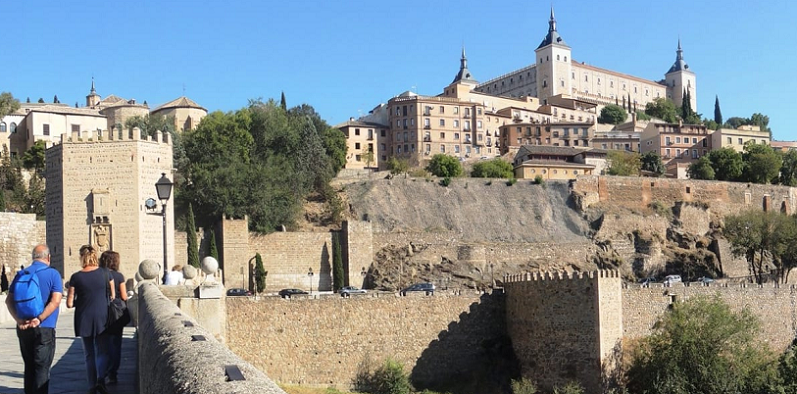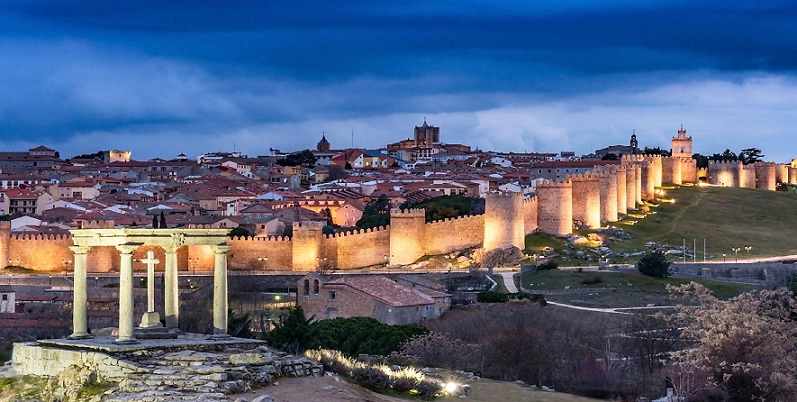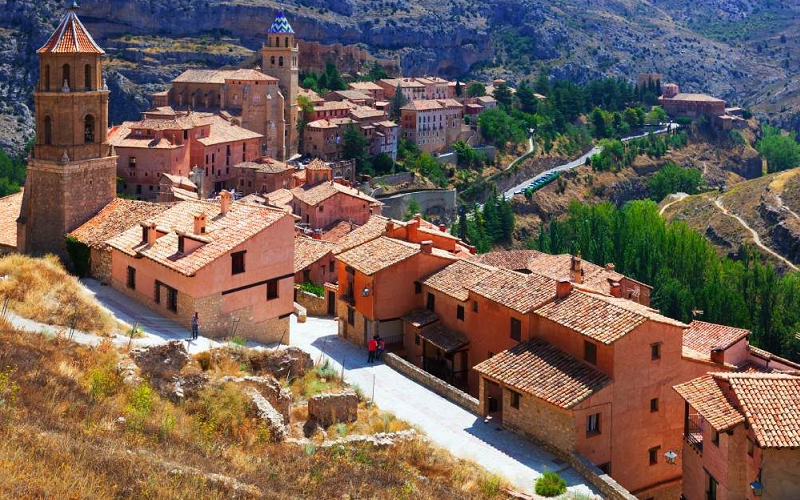Spain, a country rich in history and culture, offers a unique journey back in time through its beautifully preserved medieval towns. These towns, standing as testament to centuries past, invite travelers to explore their ancient streets, towering fortresses, and breathtaking architecture. Here we embark on an enchanting voyage to some of Spain’s most iconic medieval gems – Toledo, Segovia, and Ávila.
Each town, with its distinct character and stories, offers a glimpse into a bygone era, where the past and present merge seamlessly. From the multicultural tapestry of Toledo and the fairy-tale allure of Segovia to the fortified grandeur of Ávila, this journey is more than just a travelogue; it’s a deep dive into the heart of Spain’s medieval soul.
The Allure of Spanish Medieval Towns
Spain’s medieval towns are more than just tourist attractions; they are living museums, offering a window into a past era. The charm of these towns lies not only in their well-preserved structures but also in their ability to transport visitors to a time when knights, monarchs, and artisans walked the same cobbled streets.
Characteristics of Medieval Spanish Architecture
The architectural splendor of medieval Spanish towns is one of their most captivating features. As you walk through these towns, you’ll encounter a variety of architectural styles, from Romanesque to Gothic. Key characteristics include formidable stone walls, majestic castles, and intricate cathedrals that dominate the skyline.
Gothic elements, particularly visible in grand cathedrals, showcase pointed arches and stained glass windows, creating an atmosphere of awe and reverence. Furthermore, the layout of these towns often reveals a lot about medieval life, with narrow, winding streets designed for defense, and central squares that served as hubs of commerce and social gatherings.
The Role of These Towns in Preserving Spanish History
Medieval towns are crucial in understanding Spain’s historical tapestry. They are repositories of cultural heritage, preserving the legacy of various civilizations that have influenced the country. Towns like Toledo and Segovia are not just Spanish in character; they are a blend of Christian, Muslim, and Jewish influences, reflecting the complex history of the Iberian Peninsula.
These towns also played significant roles in historical events, from battles to political alliances, making them key chapters in the story of Spain. By visiting them, we gain a deeper appreciation for the country’s past, understanding how history has shaped modern Spain.
Spotlight on Notable Spanish Medieval Towns
In this journey through Spain’s medieval heart, we turn the spotlight on three towns that epitomize the era’s architectural grandeur and cultural significance. Each town, with its unique character and history, offers a distinct experience to the traveler seeking a blend of historical richness and contemporary charm.
Toledo: A Fusion of Cultures and Eras
Toledo, often referred to as the “City of Three Cultures,” is a remarkable example of coexistence and cultural fusion. This town was once a flourishing hub where Christian, Muslim, and Jewish communities lived side by side. The Alcázar of Toledo, a stone fortification located in the highest part of the town, offers breathtaking views and a trip into Spain’s military history [1].
The Toledo Cathedral, a masterpiece of Gothic architecture, stands as a testament to the town’s Christian legacy, while the Synagogue of Santa María la Blanca represents its Jewish heritage. Strolling through Toledo’s narrow streets, one can’t help but feel engulfed in the rich tapestry of cultures that have shaped this town.
Segovia: The Fairytale Fortress City
Next, we venture to Segovia, a town that seems lifted straight from a fairytale. Segovia’s most iconic landmark is its Roman aqueduct, one of the best-preserved monuments left by the Romans in Spain. Towering at 28 meters high, this architectural wonder has stood the test of time and continues to amaze visitors.
The Alcázar of Segovia, with its distinct ship-bow shape, is believed to have inspired the design of Disney’s Cinderella Castle. This medieval fortress is a must-visit for anyone fascinated by stories of knights and royalty. Segovia’s enchanting streets and gastronomic delights, like the famous “cochinillo asado” (roast suckling pig), add to the town’s allure, making it an unforgettable stop in our medieval journey.
Ávila: The Walled Wonder
Finally, we explore Ávila, known for its impressive medieval walls. These walls, complete with 88 towers and nine gates, encircle the old town and represent one of the most complete fortified complexes in Spain. Walking along the walls of Ávila offers a panoramic view of the town and the surrounding landscape.
The town is also famous for its Romanesque and Gothic churches, particularly the Cathedral of Ávila, which is integrated into the town’s defense system. The mystic Saint Teresa of Ávila hails from this town, and her presence is felt through various sites dedicated to her life and work. Ávila’s unique blend of religious, military, and civic architecture, set against the backdrop of the medieval walls, makes it a captivating destination for history buffs and casual travelers alike.

Toledo: The City of Three Cultures
Nestled on a hill above the plains of Castilla-La Mancha, Toledo is a vibrant tapestry of history, art, and culture. Known as the “City of Three Cultures” for its harmonious blend of Christian, Muslim, and Jewish influences, Toledo is a living museum that embodies the confluence of histories and traditions.
Must-See Toledo Historical Sites and Their Histories
Toledo’s rich history is evident in its remarkable landmarks. The Alcázar of Toledo, a majestic fortress located at the city’s highest point, has been a Roman palace, a Moorish fortification, and a royal residence. Today, it houses the Army Museum and offers visitors insights into Spain’s military history.
Another crown jewel is the Toledo Cathedral, a prime example of Gothic architecture in Spain. Its awe-inspiring façade, intricate stained glass windows, and the art-filled interior are a feast for the eyes and spirit. For a glimpse into Toledo’s Jewish heritage, the Synagogue of Santa María la Blanca, with its stunning white arches and tranquil atmosphere, is a must-visit [2].
Local Toledo Culture and Medieval Traditions Still Alive Today
Toledo is not just about its monumental heritage; it’s a city where medieval traditions thrive in modern times. The art of damascene, the intricate craft of inlaying gold or silver in steel, is a living tradition here. Artisans in workshops continue to produce exquisite jewelry and decorative items using techniques passed down through generations.
The city is also renowned for its marzipan, a sweet delicacy that dates back to the Middle Ages. Wander through the old town’s narrow streets, and you’ll find shops and cafes serving this traditional confection, often crafted into intricate shapes and patterns.
Tips for Toledo Visitors (Accommodation, Best Time to Visit)
To fully experience Toledo’s charm, consider staying overnight. The city offers a range of accommodations, from historic hotels within ancient buildings to modern lodgings outside the city walls. Visiting Toledo outside the peak summer months is advisable; the weather is more pleasant, and the streets less crowded in spring and fall. While in Toledo, don’t miss the chance to witness the city at sunset from across the Tagus River – the view of the city basking in the golden light is nothing short of magical.
Segovia: A Journey to the Past
Segovia, a jewel in the crown of Spain’s medieval towns, offers an enchanting journey into the past. With its Roman aqueduct, fairy-tale castle, and ancient streets, Segovia is a place where history comes alive, transporting visitors to a time of knights and legends.
The Iconic Segovia Aqueduct: A Roman Masterpiece
The Roman aqueduct of Segovia, an engineering marvel, is the city’s most iconic landmark. Dating back to the 1st century AD, this grand structure stretches over 800 meters and stands as a testament to Roman ingenuity. It’s not just a monument; it’s the lifeblood of the city, having supplied water for centuries.
As you stand beneath its towering arches, you can’t help but marvel at the skill and precision of ancient engineers. The aqueduct is not only a symbol of Segovia’s heritage but also a starting point for exploring the town’s charming streets and squares.
Segovia Culinary Delights: Sampling Cochinillo Asado
Segovia’s culinary scene is as rich as its history, with the “cochinillo asado” (roast suckling pig) being the star. This traditional dish, with its crispy skin and tender meat, is a culinary experience that harks back to medieval feasts.
Numerous restaurants in the old town offer their version of this Segovian specialty, often cooked in large wood-fired ovens. Alongside cochinillo, you can enjoy other local delicacies such as “judiones de La Granja” (large white beans) and local wines, providing a taste of the region’s agricultural heritage and gastronomic prowess [3].
Annual Segovia Events: Fairs and Medieval Markets
Segovia’s calendar is dotted with festivals and events that bring its medieval history to life. The town’s medieval market, usually held in June, transforms the streets into a bustling medieval bazaar. Here, vendors in period costumes sell handicrafts, and entertainers perform traditional music and dances.
The “Titirimundi” puppet festival and the Segovia Music Festival are other notable events, showcasing the town’s vibrant cultural scene. These events offer a unique opportunity to experience Segovia’s rich heritage in a festive, lively setting, making any visit during these times especially memorable.

Ávila: Enclosed in Time
Ávila, a city renowned for its imposing medieval walls, invites travelers into a world where time stands still. This UNESCO World Heritage site, with its well-preserved structures and historical ambiance, offers a unique glimpse into Spain’s medieval era.
The Walls of Ávila: A Monumental Legacy
The medieval walls of Ávila are the city’s defining feature. Built in the 11th century, these walls stretch over 2.5 kilometers, encircling the old town and providing a formidable defense in bygone times. Today, they stand as a symbol of Ávila’s historical significance. Visitors can walk along parts of the walls, enjoying panoramic views of the city and the surrounding countryside. The sight of these ancient fortifications, especially at dusk when they are lit up, is a mesmerizing experience, connecting the past with the present in a tangible, awe-inspiring way [4].
Ávila Artisanal Crafts and Local Shops
Ávila’s medieval legacy is not confined to its architecture; it extends into the realm of local crafts and commerce. The city is known for its traditional artisanal products, including ceramics, leather goods, and textile works. Strolling through the narrow streets of the old town, visitors will encounter small, family-owned shops selling handmade items, each with a story to tell. These crafts are a window into the daily life and skills of the people who have inhabited this city over the centuries, offering a personal connection to Ávila’s rich cultural heritage.
Nature Escapes: Surrounding Landscapes and Hiking Trails
While Ávila’s medieval charm is undeniable, the natural beauty surrounding the city adds another dimension to a visitor’s experience. The rolling hills and open countryside around Ávila are perfect for outdoor enthusiasts. Hiking trails lead through picturesque landscapes, offering breathtaking views and a chance to explore the region’s flora and fauna. These natural escapades provide a tranquil contrast to the historical exploration within the city walls, making Ávila a well-rounded destination for all types of travelers.
References
[1] Must-see Medieval Towns in Spain
[2] Europe’s Best-Preserved Towns
[3] A route through Spain’s medieval towns and cities
[4] 17 of the most beautiful medieval villages in Spain

